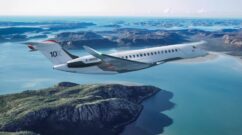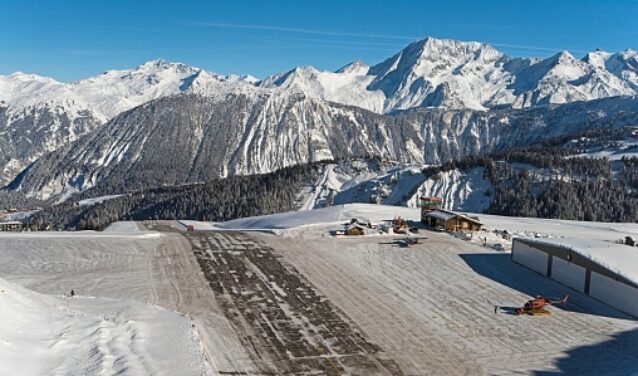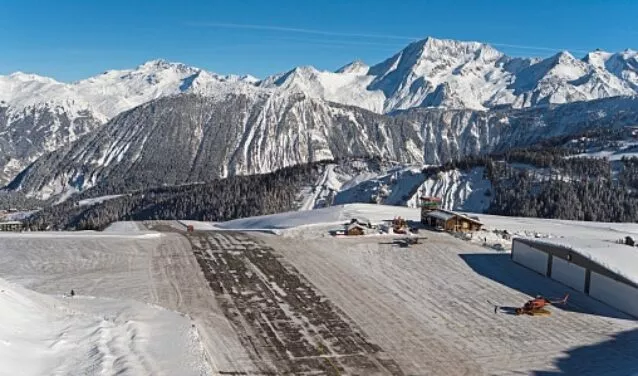
Although flying remains the world’s safest mode of transport, some airports turn every landing or take-off into a technical feat. Even for the most experienced pilots, these extraordinary runways demand surgical precision, perfect mastery of currents and sometimes… a little nerve.
From dizzyingly steep approaches to short runways overhanging the ocean and take-offs between mountains, these spectacular airports offer passengers breathtaking views – and the occasional cold sweat. Ready to discover the most impressive?
Here’s our TOP 10 of the world’s most daring airports, selected by our aviation experts.
1. Tenzing-Hillary Airport – Lukla, Nepal: The gateway to Everest
Altitude: 2,895 m
Runway length: 485 m
Nestled 2,895 meters above sea level in the Nepalese Himalayas, the runway atTenzing-Hillary airport is a must for adventurers in search of the roof of the world. Nicknamed “the gateway to Everest”, the airport pays homage to the legends Tenzing Norgay and Edmund Hillary, who first conquered the summit in 1953.
To better understand the particularities of this unique site, let’s delve into its features and history.
1. An extraordinary trail
With a length of 527 metres (compared with an average of 2,000 m for a conventional runway) and a gradient of 12%, the airstrip defies the laws of aeronautics. Pilots, trained specifically for this route, must make a daring approach between two mountain walls, guided by the control tower. To the east, a vertiginous 700-metre drop; to the west, a sheer cliff: a configuration that demands precision and composure.
2. Challenges and adaptations
The changing weather conditions at high altitude add to the complexity. Sudden fog, strong winds and torrential rain frequently delay flights, which are mainly carried out by light aircraft (such as the Twin Otter). To ensure safe operations, take-offs take place early in the morning, when the skies are clearest.
3. A place steeped in history
Opened in 1964 and coded VNLK, this airport was built to support the growth of mountaineering in the region. Today, it welcomes some 50,000 trekkers a year, many of whom then take the trail to Everest Base Camp.
4. Travel tips
Fly in spring or autumn, the most stable seasons. In addition, leave a margin in your itinerary in case of climatic contingencies.
As you approach, the left-side windows offer a breathtaking view!
Between the adrenalin rush and the breathtaking scenery, landing in Lukla is a memorable experience, where man and nature live side by side… under the sign of the extreme.
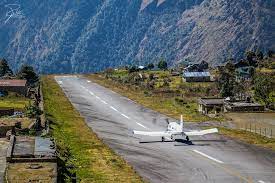
Photo credit : Flickr
Discover more about this airport in Lukla – Nepal, and the possibilities of flying there in a private jet.
2. Paro International Airport – Bhutan: between technical prowess and Himalayan landscapes
Altitude: 2,235 m
Runway length: 1,964 m
Bhutan’s only international airport, Paro is a spectacular gateway to the heart of the Himalayas. Nestled at an altitude of 2,235 m, it is surrounded by vertiginous peaks topping 5,000 m, including Mount Jomolhari (7,326 m).
This unique geographical setting makes it one of the world’s most perilous airports, reserved for a handful of experienced pilots.
1. A technical and human challenge
The approach to the runway, narrow and short (2,000 m), demands extreme precision: pilots must make a tight descent through the valleys, with 45-degree turns, to align the aircraft at the last moment.
Only 22 pilots worldwide are certified to land here, all of them trained specifically for this course under the supervision of the Bhutanese aviation authority.
Flights are prohibited at night and subject to strict weather conditions.
2. An unforgettable experience
For travelers, landing in Paro offers breathtaking views of perched monasteries and terraced rice fields.
This aeronautical feat, combined with Bhutan’s policy of preserving its authenticity, limits air traffic and reinforces the mystical aura of the “Land of the Thunder Dragon”.
The airport, inaugurated in 1968 and modernized in 2023, remains a symbol of the balance between modernity and tradition.
Note: The national airline Drukair operates the majority of flights, linking Paro to regional hubs such as Delhi, Bangkok and Singapore.
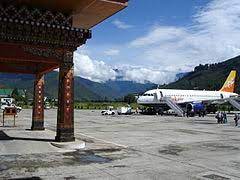
Photo credit : WIkipedia
3. Juancho E. Yrausquin Airport – Saba Island, Netherlands Antilles
Runway length: 400 m
Juancho E. Yrausquin Airport – Saba, Dutch Caribbean
Perched on the volcanic island of Saba, a Dutch territory in the Caribbean, Juancho E. Yrausquin airport boasts a unique feature: its 400-meter runway, the shortest in the world open to commercial traffic. Nestled between verdant hills and overlooking the ocean, this strip of asphalt ends abruptly in cliffs plunging into the turquoise waters, offering a spectacle both dizzying and captivating.
Let’s take a look at its technical and logistical features:
- An aeronautical challenge: pilots must master Visual Flight Rules (VFR) to land or take off, with millimetric precision due to the absence of any margin for error.
- Target audience: Mainly served by local airline Winair, the airport connects Saba with Saint-Martin (12-minute flights) and Saint-Eustache, making it easily accessible to adventure-seeking travelers.
- Alternatively, for less adventurous travelers, ferries provide a longer but less intense sea link to neighboring islands.
Despite these technical challenges, the airport cultivates an intriguing paradox:
Ranked as one of the “world’s most dangerous airports”, Juancho E. Yrausquin (IATA code: SAB) has nonetheless boasted an unblemished safety record since 1963. This success is due to limited traffic, rigorous maintenance and pilots specially trained for this unusual runway.
Beyond its aeronautical achievements, Saba is well worth a visit for :
- Its world-renowned diving spots, including the famous protected marine reserves.
- Its steep hiking trails, leading to Mount Scenery (887 m), the highest point in the Netherlands.
- Its unspoilt charm, far from mass tourism, with picturesque villages of red houses with white roofs.
In short, this airport is not just a technical curiosity: it embodies the adventurous soul of Saba. Between the adrenalin of a spectacular landing and the tranquility of an unspoilt island, the experience is unforgettable – a perfect balance of daring and serenity.
“Here, every landing is a story to be told – Testimonial from a Winair pilot.
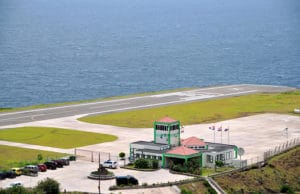
Photo credit: istockphoto
4. Courchevel Altiport – France
Runway length: 537 m
Incline: 18.5° (the steepest in the world!)
Located at an altitude of 2,007 meters in the heart of the French Alps, the Courchevel altiport is an aeronautical feat as fascinating as it is formidable. Accessible only by air, it represents a major challenge for pilots, who must obtain specific certification to land there. The reason for this? Its unique runway, the shortest in the Alps (537 metres), has a record gradient of 18.5 degrees – the steepest in the world.
This particularity imposes some counter-intuitive maneuvers: planes take off downhill to gain speed, and land uphill to brake effectively. A vertiginous experience for passengers, but also a captivating spectacle for visitors watching from the lifts.
A mythical place, the altiport made its mark on popular culture when it appeared in James Bond: Tomorrow Never Dies (1997), where Pierce Brosnan played a breathless landing. Today, it serves mainly as a VIP access point to the resorts of Courchevel and Méribel, while attracting aviation enthusiasts in search of extreme challenges.
And don’t forget: its spectacular Alpine setting and status as “the world’s most dangerous runway” make it a must for thrill-seekers… and movie buffs!

Photo credit: Getty image
find out more about this Courchevel Airport in France, and how to get there by private jet or helicopter.
5. Matekane Airstrip Airport – Lesotho: a vertiginous runway in the service of humanitarian aid
Runway length: 400 m
Precipice: 600 m of empty space at the end of the runway
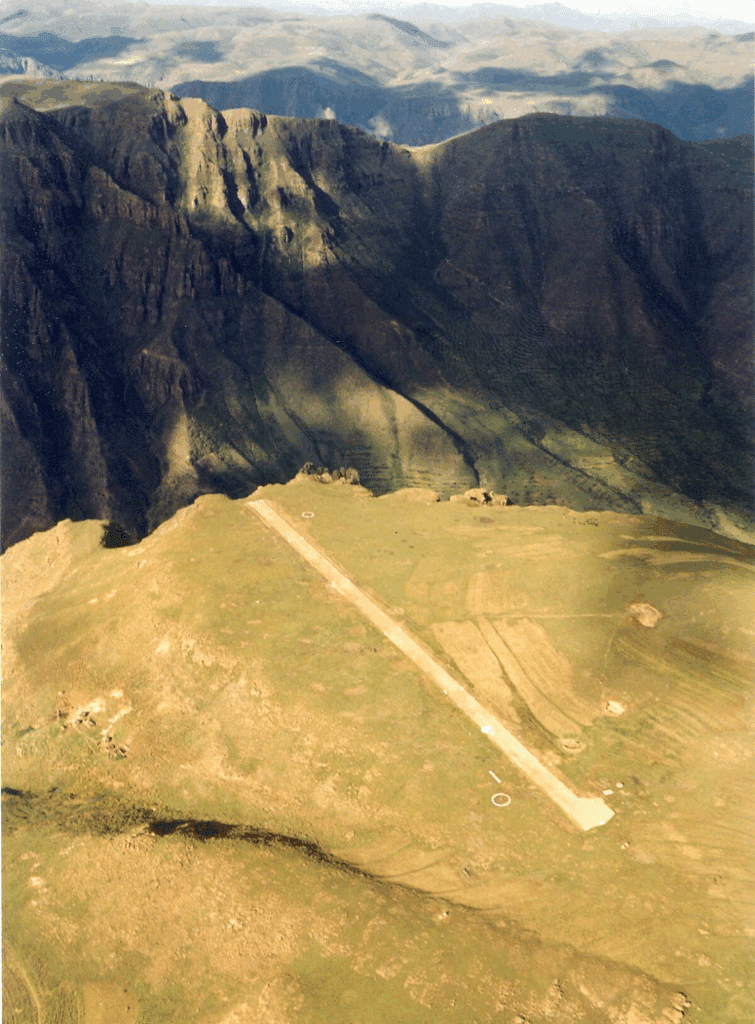
Image source: Wikipedia
Perched at the heart of an awe-inspiring landscape, reminiscent of the vast wilderness of Out of Africa, the Matekane airstrip in Lesotho is one of the most perilous in the world.
Just 400 metres long – a distance well below aeronautical standards, even for small aircraft – it demands extreme precision from pilots.
What makes it special? It ends abruptly at a 600-metre-deep ravine, turning every take-off into a real challenge.
Only a handful of aircraft dare to land here, and then only for humanitarian missions or medical emergencies. This runway, vital to the region’s isolated communities, is a testament to the courage of the air crews and the need to adapt to a hostile geography. A delicate balance between audacity, ingenuity and solidarity, in the service of those who have no other access to the world.
Additional background: The aircraft used are generally light models, like the Cessna 208, specially adapted for short landings. The runway, located at an altitude of over 2,300 meters, adds a technical complexity due to the rarefaction of the air, affecting engine performance.
6. Madeira Cristiano-Ronaldo International Airport – Portugal
Runway length: 2,781 m (partially on piles)

Image source: Wikipedia
Located near Funchal, this island airport is as famous for its eventful history as for its bold architecture.
Here are the key factors to remember about this airport:
- A bold runway over the ocean
The original 1,600-metre runway was the scene of several crashes in the 1970s and 1980s, due to high winds and complex terrain. To make operations safer, a Pharaonic project was undertaken: between 1986 and 2000, the runway was extended to 2,781 metres, with almost half of its structure built on the Atlantic Ocean.
Supported by 180 reinforced concrete pylons (average height: 70 metres), this extension earned it the nickname “runway on stilts”, and remains a world benchmark in airport engineering.
- A constant challenge for pilots
Despite these improvements, conditions remain demanding: unpredictable crosswinds, frequent turbulence and the need for a curved approach to avoid the mountains. Only pilots certified after specific training are allowed to land here.
- A tourist and technical icon
Renamed in 2017 as a tribute to Madeira-born Cristiano Ronaldo, the airport blends technical heritage with local pride. Its panoramic balcony attracts aviation enthusiasts, while its spectacular runway has become a symbol of the human ability to tame the elements.
Note: Today, the airport serves international flights and plays a key role in Madeira tourism, hosting long-haul aircraft such as the Boeing 747.
Find out more about Madeira Cristiano-Ronaldo Airport in Portugal, and how to get there by private jet or helicopter.
7. São Paulo-Congonhas Airport (CGH) – Brazil
Location: Downtown

Source image : Wikipedia
Located less than 8 km from downtown São Paulo, Congonhas airport is a fascinating and controversial symbol of urban engineering. Inaugurated in 1936, it remains one of Brazil’s busiest airports, with almost 20 million annual passengers before the pandemic.
Here are the key factors to remember about this airport:
- An aeronautical challenge in an urban environment
The airport’s spectacular take-offs and landings offer a striking experience: planes fly at low altitude over residential buildings, business districts and even the roofs of houses, under the accustomed – but sometimes worried – gaze of local residents. This proximity to the city, while convenient for travellers, imposes strict safety procedures and weight limits on aircraft.
- A runway feared in extreme weather conditions
The short, asphalt main runway (1,940 m) becomes particularly slippery during tropical rains, a phenomenon exacerbated by its sloping profile. After the tragic accident in 2007 (flight TAM 3054, 199 victims), grooves were dug to improve water drainage and tighter controls were introduced.
- History and risk prevention
Congonhas has experienced two major accidents:
- 1996: A TAM Fokker 100 ran off the runway, killing 99 people.
- 2007: Collision of TAM flight 3054, due to a combination of rain, pilot error and mechanical failure.
Despite these tragedies, the airport remains an essential link in the Brazilian transport chain, combining modernity with historical challenges. Projects to reduce traffic, partly transferred to Guarulhos airport, are attempting to reconcile safety with growing demand.
Note: The airport takes its name from “Congonhas”, a tribute to the region’s ancient mate plantations (erva-mate), now lost to urban expansion.
Find out more about this São Paulo/Congonhas Airportin Brazil, and how to get there in a private jet.
8. Toncontin International Airport – Tegucigalpa, Honduras
Runway length: 2,000 m
45° approach on final
Image source: Wikipedia
Nestled in the heart of a mountainous amphitheatre, the Toncontin runway is a legendary aeronautical challenge. With a length of just 2,013 meters, it demands surgical precision from pilots, particularly on final approach. They must execute a tight 45-degree turn at low altitude, moments before landing, to avoid the surrounding terrain.
Here are the key factors to remember about this airport:
- A technical and historical heritage
Opened in 1934, this airport has long been the main gateway to the Honduran capital. Its atypical configuration, inherited from the geographical constraints of the Tegucigalpa valley, makes it one of the most complex take-off and landing airports in the world. Following two major accidents – the crash of TACA Flight 390 in 2008 (5 deaths) and that of Sahsa Flight 414 in 1989 (131 victims) – restrictions were tightened, limiting its use to regional aircraft and specially certified crews.
- Between fascination and caution
While travelers are often captivated by the spectacular view of the mountains brushed by the aircraft’s wings, Toncontin remains a symbol of human resilience in the face of nature. Now partially replaced by Palmerola airport (2017), it still operates for domestic and private flights, perpetuating its status as an aeronautical legend.
Why does this runway survive? Because it embodies the audacity of Latin American engineering, and reminds us that every successful landing is a discreet victory over the elements.
9. Princess Juliana International Airport – Saint-Martin
Special feature: Beach-level approach

Image source: Wikipedia
Located on the island of Saint-Martin, Princess-Juliana International Airport (code SXM) is famous for a unique feature: its runway starts just a few meters from Maho Beach, a beach crowded with tourists. This spectacular proximity offers a breathtaking spectacle: during landings, the planes fly over the beach at such a low altitude that they seem to skim over the umbrellas and visitors lying on the sand.
Although photos of jumbo jets flying over bathers have made the rounds of social networks, the scene is more of an aeronautical curiosity than a real danger. Pilots follow strict approach procedures, and signs warn tourists of the risks associated with jet turbulence. Despite these warnings, many travelers brave the gusts of wind to live the experience or immortalize the moment.
Did you know?
- Maho Beach has become a mythical spot for plane spotters and thrill-seekers.
- The most impressive flights are those by Boeing 747s and other long-haul aircraft, now gradually being replaced by more modern aircraft.
- The airport plays a vital role in local tourism, with connections to Europe, North America and the Caribbean.
Between adrenalin and fascination, this iconic location perfectly embodies the bold, photogenic spirit of Saint-Martin. A visit not to be missed… but to be enjoyed with caution!
Find out more about this Princess Juliana – Saint-Martin International Airport and how to get there by private jet.
10. Gibraltar International Airport: a unique infrastructure
Special feature: Runway crossing an urban road
Image source: Wikipedia
Nestled between the Mediterranean Sea and the emblematic Rock of Gibraltar, this airport boasts a striking feature: its runway crosses Winston Churchill Avenue, the main road linking the British territory to Spain. A singularity that makes it one of the most unusual airports on the planet.
Here are the most important facts about this airport:
1. Surprising cohabitation between aircraft and motorists
During take-off and landing, a system of barriers temporarily blocks traffic, forcing vehicles to pause. Although safe, this air-land ballet generates frequent delays, especially during rush hour. It’s a daily spectacle that attracts curious onlookers and photographers alike!
2. Technical specifications and operational challenges
With a runway measuring 1,829 metres (approx. 6,000 feet), the airport mainly handles short-haul flights (EasyJet, British Airways) and regional aircraft. This length limits access for wide-bodied aircraft, requiring precision maneuvering on the part of pilots, compounded by the sometimes capricious winds from the Strait.
3. Historical background and future challenges
Built during the Second World War, the site is today at the heart of debates over its extension, in the face of growing traffic and logistical tensions with Spain. Despite these challenges, it remains a symbol of Gibraltar’s identity, combining history, innovation and urban adaptation.
A unique travel experience, where the thrill of landing rivals the astonishment of seeing planes and cars sharing the same space!
Find out more about Gibraltar – Saint-Martin International Airport and how to get there in a private jet.
Need a private flight in complete safety?
Our aviation experts are at your service 24/7 for your private flight at +33 (0) 1 44 09 91 82.
Don’t hesitate to use our online quote to obtain a price estimate for your private flight.
With over 20,000 aircraft available and 45,000 flights insured, we guarantee an exceptional flying experience.


